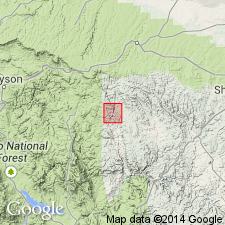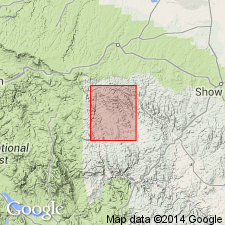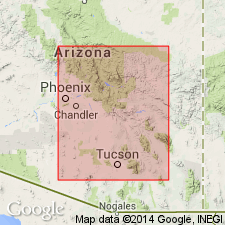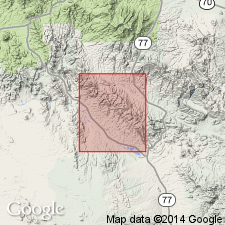
- Usage in publication:
-
- Chediski white sandstone member*
- Modifications:
-
- First used
- Dominant lithology:
-
- Sandstone
- AAPG geologic province:
-
- Black Mesa basin
Summary:
First published use as the basal member of the Troy quartzite. [Named presumably] for Chediski Mountain, on Fort Apache Indian Reservation, Navajo Co, AZ in the Black Mesa basin. Intent to name and designation of type not stated. Overlies Mescal limestone. Underlies unnamed quartzite of Troy. Is 50-100 ft thick. Made up of fine- to medium-grained white sandstone with white sericitic cement. Of Cambrian? or pre-Cambrian age.
Source: GNU records (USGS DDS-6; Denver GNULEX).

- Usage in publication:
-
- Chediski Sandstone Member*
- Modifications:
-
- Age modified
- Overview
- AAPG geologic province:
-
- Black Mesa basin
Summary:
Report area includes Chediski Mountain [source of geographic name], Navajo Co, AZ, Black Mesa basin. Author includes a more complete lithologic description of the Chediski than Burchard, so description is given here. Mapped as basal member of Troy Quartzite. Assigned a late Precambrian age, a change in age designation [though not stated] from assignments in earlier papers. Overlies Mescal Formation of Apache Group. Underlies upper quartzite member of Troy. Ranges from 115 to 220 ft thick. Divisible into 1) basal 1-40 ft thick yellow-gray to red-brown slope- and cliff-forming conglomeratic sandstone that has a matrix of quartz and chert grains ranging from medium to very coarse, and clasts of chert quartzite, basalt, and hematite as much as 8 inches in diameter; 2) middle gray steep slope-forming sandstone, that is 95 to 100 ft thick, weathers white, fine to coarse grained, micaceous, massive to thin-bedded; 3) upper gray and brown, 15-80 ft thick, medium- to coarse-grained, conglomeratic sandstone that is cliff-forming eolian, cross-bedded in tabular to wedge-shaped sets with thin lenses of subangular to subround white quartz pebbles between sets.
Source: GNU records (USGS DDS-6; Denver GNULEX).

- Usage in publication:
-
- Chediski Sandstone Member*
- Modifications:
-
- Overview
- Reference
- AAPG geologic province:
-
- Basin-and-Range province
Summary:
Is the middle member of Troy Quartzite in Basin-and-Range province. Reference section measured for Troy in secs 16, 21, and 22, T6N, R14E includes a detailed description of Chediski, which overlies the arkose member and underlies the quartzite member. Assigned a younger Precambrian age.
Source: GNU records (USGS DDS-6; Denver GNULEX).

- Usage in publication:
-
- Chediski Sandstone Member*
- Modifications:
-
- Age modified
- AAPG geologic province:
-
- Basin-and-Range province
Summary:
Age revised from late Precambrian to: Precambrian Y based on age revision stated for Troy Quartzite. This is a belated entry as age revision for unit was not made at same time as age revision for Troy Quartzite.
Source: GNU records (USGS DDS-6; Menlo GNULEX).
For more information, please contact Nancy Stamm, Geologic Names Committee Secretary.
Asterisk (*) indicates published by U.S. Geological Survey authors.
"No current usage" (†) implies that a name has been abandoned or has fallen into disuse. Former usage and, if known, replacement name given in parentheses ( ).
Slash (/) indicates name conflicts with nomenclatural guidelines (CSN, 1933; ACSN, 1961, 1970; NACSN, 1983, 2005, 2021). May be explained within brackets ([ ]).

